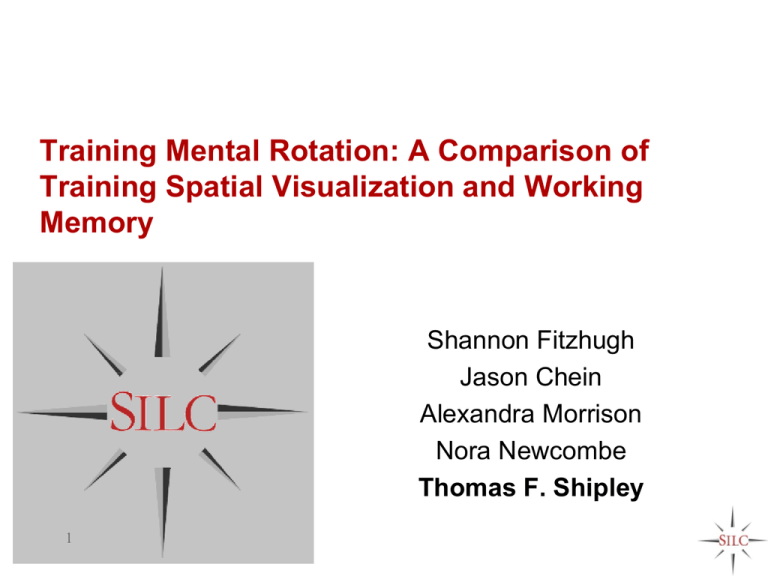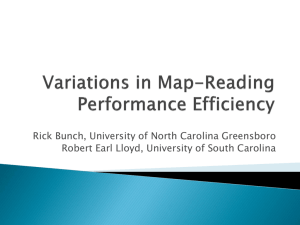Shipley, Fitzhugh, Chein, Morrison and Newcombe
advertisement

Training Mental Rotation: A Comparison of Training Spatial Visualization and Working Memory Shannon Fitzhugh Jason Chein Alexandra Morrison Nora Newcombe Thomas F. Shipley 1 Perception and Cognition with Spatial Representations 2 http://www.spatialintelligence.org Training What we know about training…. •Working Memory Training improves executive function and reading comprehension •Spatial Visualization Training improves Mental Rotation, help retain women in STEM disciplines (engineering) What we don’t know about training…. •What is the mechanism? •Is the mechanism domain general (i.e. executive functioning) or domain specific (i.e. spatial ability) •Are the profiles of change the same for all groups of people? 3 http://www.spatialintelligence.org Experimental Design Pre-test of cognitive skill level Spatial Visualization Training Working Short Term Memory Training Memory Training Post-test of cognitive skill level 4 http://www.spatialintelligence.org Methods •Results as Composite Z-Score •Verbal – average z-score for all verbal assessments (Nelson Denny, operation span) •Spatial – average z-score for all spatial assessments(Paper-and-pencil MRT-A, symmetry span, Paper folding (ETS), Surface development (ETS)) •Eye-tracking Training Paradigms “N” times – adaptive portion • Verbal WM training (adaptive complex span) Feedback Lexical decision Memory item Response “N” times – adaptive portion 4s • 1s Verbal STM training (adaptive simple span) Feedback No Processing Memory item •Spatial Visualization Training (progressive workbook;Sorby, 2003) 6 http://www.spatialintelligence.org Response Difference in Verbal Composite Z-Scores by Training Z-Score Difference Pre to Post Training 1 Measures: Nelson Denny Operation span 0.9 0.8 0.7 0.6 Spatial Visualization 0.5 Working Memory 0.4 * Short Term Memory 0.3 N=16 N=15 0.2 0.1 * significant at p=.05 N=21 0 Training Group 7 http://www.spatialintelligence.org Difference in Pre-Post Z-Scores 1 0.9 0.8 0.7 Difference in Spatial Composite ZScores by Training Measures: ** N=21 ** ** N=15 MRT Symmetry span Paper folding Surface development N=16 0.6 Spatial Visualization Working Memory Short Term Memory 0.5 0.4 0.3 0.2 0.1 ** significant at p=.001 0 Training Groups 8 http://www.spatialintelligence.org Visualization Training Facilitates Encoding Average RT Difference Pre/Post Test 0.6 Mental Rotation Reaction Time Difference by Training Group 0.4 N=5 0.2 0 * N=4 -0.2 Spatial -0.4 WM -0.6 N=4 STM -0.8 -1 * Significant at p=.05 -1.2 -1.4 9 http://www.spatialintelligence.org Eye Tracking: Gaze Change Working Memory Short Term Memory Spatial Visualization 10 http://www.spatialintelligence.org Conclusions •Memory training improves both verbal and spatial abilities (improving attention). •Visualization training improves spatial skills (Improving encoding) •Training effects and individual spatial abilities •WM improves performance on WM tasks for all groups and MRT performance for all groups •Spatial Training improves performance on spatial tasks for high and low ability only – non-rotators remain flat 11 http://www.spatialintelligence.org




